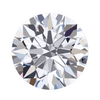Diamond Education
Diamond Shapes
a Diamond's shape (round, princess, radiant, etc.) describes its form, primarily as viewed from above. All diamond shapes have different attributes, but overall the beauty of the individual shapes is a matter of personal taste. Since all diamond shapes are very different, unique characteristics determine quality for each shape. Look at the shapes below to learn how to recognize your ideal diamond shape. If you have additional questions, feel free to contact one of our Diamond and Jewelry Consultants who can help you find the diamond that's perfect for you.

Diamond Carat Weight?
Carat is a measure of a diamond's weight, and by itself may not accurately reflect a diamond's size.
We tend to evaluate diamond size by viewing it from the top because that is how diamonds are presented to us when setting into a ring.
To understand diamond size, carat weight should be considered in conjunction with two other criteria:
- Distance in millimeters across the top of the diamond.
- Diamond's cut grade.
As the name suggests, carat weight specifically refers to a diamond's weight. However, much as a person's weight does not necessarily correlate with height, carat weight, by itself, may not accurately reflect a diamond's size. To gain a precise understanding of diamond size, CVD Diamond recommends considering carat weight with two other characteristics:
1) the distance across the top of the diamond measured in millimeters.
2) the diamond's cut grade.
A diamond's cut grade should also be considered because, as we noted in the cut grade section, when a diamond is cut with the proper proportions, the maximum amount of light (or sparkle) is returned out of the top of the diamond. Thus, when a diamond is well cut, the light reflected out of the top makes it appear larger. In addition, much of the weight of a poorly cut diamond, for example, may be "hidden" in the base of the diamond, making the diamond appear smaller than its carat weight would imply.
It is therefore possible to have a diamond of a lower carat weight, but higher cut grade, that appears larger than a diamond with a larger carat weight, but poor cut.
Once you've selected your cut, color, and clarity grade, it's easy to determine the carat weight of diamond that will fit within your budget.
Much as there are 100 pennies in a dollar, a one-carat diamond is comprised of 100 points. Hence, 50 points is equal to 1/2-carat, and so on.
This chart illustrates how diamonds of different carat weights look when set in a ring. Note that a 2-carat diamond does not appear to be twice the size of a 1-carat diamond when viewed from the top.

Clarity
The clarity of a diamond refers to the amount, size, type and location of internal flaws (inclusions) or surface imperfections (blemishes) visible in a diamond using 10x magnification. All diamonds have imperfections in them. The "cleaner" the diamond, the higher the value. The following are the standard grades of diamond clarity: FL= Flawless -- No inclusions and no blemishes visible under 10x magnification, the most rare and expensive of all clarity grades. IF= Internally Flawless -- No inclusions visible under 10x magnification, but there may be some tiny external irregularities in the finish. VVS-1= Very Very Slightly Included 1 -- usually just one tiny inclusion visible only to a trained eye under 10x magnification. VVS-2= Very Very Slightly Included 2 -- tiny inclusions visible only to a trained eye under 10x magnification. VS-1= Very Slightly Included 1 -- very small inclusions visible with 10x magnification. VS-2= Very Slightly Included 2 -- several very small inclusions visible with 10x magnification. SI-1 and SI-2 = Slightly Included 1 and 2 – noticeable inclusions that are easily seen under 10x magnification. Many inclusions and blemishes are too tiny to be seen by anyone other than a trained diamond grader. To the naked eye, a VS1 and an SI2 diamond may look exactly the same, but these diamonds are quite different in terms of overall quality. This is why expert and accurate assessment of diamond clarity is extremely important.
 The following chart gives some examples of how each grade might look under a 10x loupe.
The following chart gives some examples of how each grade might look under a 10x loupe.
Color
Grading color determines how closely a diamond's color approaches colorlessness. With the exception of fancy color diamonds, the colorless grade is the most valuable. If a diamond does not have enough color to be called fancy, then it is graded on a scale ranging from Colorless to Light Yellow or "D" through "Z." A "D" color diamond is considered colorless. If the color is more intense than "Z," it is considered fancy. A fancy yellow diamond will sell for a far higher price than a light yellow diamond.

Subheading
Image with text
Use this text to share information about your brand with your customers. Describe a product, share announcements, or welcome customers to your store.















